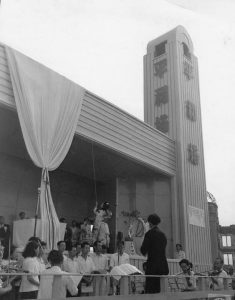Documenting Hiroshima 80 years after A-bombing: On August 6, 1947, first Peace Festival sends message to world
Jan. 26, 2025
by Kyosuke Mizukawa, Senior Staff Writer
At 8 0’clock in the morning on August 6, 1947, two years after the atomic bombing, the main ceremony of the first Peace Festival got underway in Hiroshima City. Around 2,500 people were in attendance at the event, which was held at Peace Plaza in one part of Nakajima-honmachi (in what is now Peace Memorial Park, in the city’s present-day Naka Ward), an area in the city that had been devastated in the atomic bombing due to its proximity to the hypocenter. The wish for peace was strongly communicated to the world.
The Peace Festival was organized by the Hiroshima Peace Festival Association, which had been formed in June by the Hiroshima City government, the Hiroshima Chamber of Commerce and Industry, and the Hiroshima Tourism Association. The Peace Plaza name had been decided after proposals were solicited from citizens. Peace Tower and an open-air concert hall had also been constructed on the plaza. The ceremony’s program included the “Peace Declaration,” “Peace Bell,” “Release of Pigeons,” and “Peace Song Chorus,” a lineup that continues to serve as a model for the present-day Peace Memorial Ceremony. Members of the occupation military forces also attended the ceremony, along with journalists representing the international media.
In August the previous year, the Peace Restoration Festival had been held in Hiroshima, but the Peace Festival Association worked to further enhance the significance of the festival with the aim of making it “a global event.” That desire was expressed in the prospectus for the association’s establishment (archived at the Hiroshima Municipal Archive), dated June 20, 1947, which read, “We are strongly, strongly crying out for, ‘The establishment of lasting peace,’ with all of our hearts as people of Hiroshima.” The previous month, on May 3, Japan’s new constitution had been enacted, including the document’s Article 9, which renounces war.
Then Hiroshima City Mayor Shinso Hamai read aloud the first Peace Declaration. “August 6, 1945, is a date the citizens of Hiroshima will never truly be able to forget,” he said. In April, Mr. Hamai, 42 at the time, had assumed the post as the first democratically elected mayor of the city and was also serving as chair of the Peace Festival Association. In his book Genbaku Shicho (in English, ‘A-bomb mayor’), published in 1967, he wrote that the mid-summer sunshine was as strong on the day of the festival as it was on “that day,” August 6, 1945.
(Originally published on January 26, 2025)
At 8 0’clock in the morning on August 6, 1947, two years after the atomic bombing, the main ceremony of the first Peace Festival got underway in Hiroshima City. Around 2,500 people were in attendance at the event, which was held at Peace Plaza in one part of Nakajima-honmachi (in what is now Peace Memorial Park, in the city’s present-day Naka Ward), an area in the city that had been devastated in the atomic bombing due to its proximity to the hypocenter. The wish for peace was strongly communicated to the world.
The Peace Festival was organized by the Hiroshima Peace Festival Association, which had been formed in June by the Hiroshima City government, the Hiroshima Chamber of Commerce and Industry, and the Hiroshima Tourism Association. The Peace Plaza name had been decided after proposals were solicited from citizens. Peace Tower and an open-air concert hall had also been constructed on the plaza. The ceremony’s program included the “Peace Declaration,” “Peace Bell,” “Release of Pigeons,” and “Peace Song Chorus,” a lineup that continues to serve as a model for the present-day Peace Memorial Ceremony. Members of the occupation military forces also attended the ceremony, along with journalists representing the international media.
In August the previous year, the Peace Restoration Festival had been held in Hiroshima, but the Peace Festival Association worked to further enhance the significance of the festival with the aim of making it “a global event.” That desire was expressed in the prospectus for the association’s establishment (archived at the Hiroshima Municipal Archive), dated June 20, 1947, which read, “We are strongly, strongly crying out for, ‘The establishment of lasting peace,’ with all of our hearts as people of Hiroshima.” The previous month, on May 3, Japan’s new constitution had been enacted, including the document’s Article 9, which renounces war.
Then Hiroshima City Mayor Shinso Hamai read aloud the first Peace Declaration. “August 6, 1945, is a date the citizens of Hiroshima will never truly be able to forget,” he said. In April, Mr. Hamai, 42 at the time, had assumed the post as the first democratically elected mayor of the city and was also serving as chair of the Peace Festival Association. In his book Genbaku Shicho (in English, ‘A-bomb mayor’), published in 1967, he wrote that the mid-summer sunshine was as strong on the day of the festival as it was on “that day,” August 6, 1945.
(Originally published on January 26, 2025)








